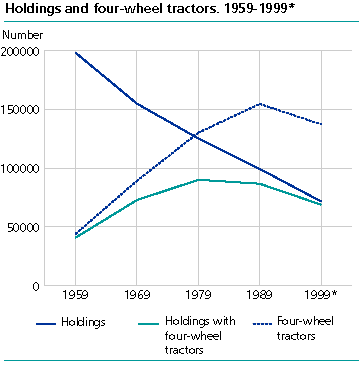Content
Published:
This is an archived release.
Hiring of machinery in farming widespread
Hiring and sharing machinery are practised on a large scale in farming. Fully 36 000 holdings hired machinery and operators for one or more jobs in 1999. In addition, 21 000 holdings pool machinery.
In the last 10 years the scope of machinery contracting for others, hiring machinery with an operator and various forms of machinery sharing have become more common. Machinery and implements are becoming larger and more efficient, but the cost of owning them is increasing. Changed roughage harvesting methods have also contributed to increased hiring and sharing of machinery.
In 1999, farmers on 14 400 holdings performed custom work for others for pay and 36 000 holdings hired machinery. The main activities are baling of round bales and wrapping of roughage and straw, although cutting roughage is also widespread. Around 30 per cent of the holdings that raise grain hire the combining done. Many farmers also take on non-farm machinery contracting jobs such as removing snow.
A further 21 000 holdings shared machinery. This is particularly widespread in connection with soil preparation and seeding, although it is also done on a large scale in combining and harvesting of roughage.
Tractors and combines
There were 138 000 four-wheel-drive tractors on holdings with agricultural land in production in 1999, while there were 155 000 in 1989. This is a reduction of 17 000 or 11 per cent. The reason for the decline is mainly the reduction in holdings. The trend towards fewer but larger holdings is also reflected in the number of tractors per holding. The number of holdings with three or more tractors is increasing. On average, there were 1.9 four-wheel-drive tractors per holding in 1999, against 1.0 in 1979 and 1.6 in 1989.
In 1979 there were 35 200 holdings without four-wheel-drive tractors, while in 1999 there were 2 800. During this period, 53 600 holdings ceased operations.
There were 14 200 combines in 1999, and 800 of these were on holdings that did not raise grain that year. The 1989 census recorded 16 700 combines, including pull-type models. 14 600 grain-raising holdings had combines in 1999 (this includes 2 500 that owned shares in combines). This compares with 17 700 in 1989. The number of holdings raising grain has been reduced from 33 100 to 22 100 during this period.
Outbuildings
135 300 outbuildings were connected with the agricultural holdings in 1999. These have a combined area of 29.8 million m2, corresponding to 220 m2 per outbuilding. Over half of the outbuildings were built before 1960. Building activity was particularly high in the 1980s, when 21 700 outbuildings were erected. In the 1990s, 12 800 outbuildings were built, the same as in the 1960s. Fully 54 500 outbuildings were remodelled or added on to. Although few buildings were built in the 1990s, fully 22 000 or 17 per cent of the outbuildings were remodelled or added on to during this period.
Many holdings actively engaged in farming have buildings that are not used but are in usable condition. 10 100 buildings with an area of 1.4 m m2 are not in use. This corresponds to nearly five per cent of the combined building stock.
The 1999 farm census includes only holdings actively engaged in farming, and outbuildings, machinery and implements on holdings that have ceased operations are not covered by the census. Consequently, there are considerable resources, particularly in the form of outbuildings, that have not been enumerated.
Emergency generators and fire alarm systems on farms with livestock
Because the production volume on individual holdings has increased, damage caused by fire and lengthy power failures is often extensive. Holdings with poultry and pigs are dependent on electricity for both ventilation and heating, while dairy farms depend on electricity for milking etc. 8 500 holdings with livestock had access to emergency generators in 1999.
Fire alarm systems for farm buildings did not come on the market until a few years ago. 3 400 farms with livestock had an approved fire alarm system in 1999, but there is currently a high level of activity in this area.
Tables:
- Table 1 Number of holdings with four-wheeled tractors and self-propelled combine harvesters, 1979, 1989, 1999*
- Table 2 Number of holdings with transportation for others, hiring of machinery and machinery cooperation by type of activity. August 1998 - July 1999*
- Table 3 Farm buildings total and farm buildings partly or totaly out of use. Number, ground area and average ground area. 1999*
- Table 4 Number of farm buildings and farm buildings shared according to percentage by year of construction, 1999*
- Table 5 Number of holdings with animal husbandry which has fire alarm or emergency electric unit. 1999*
Contact
-
Statistics Norway's Information Centre
E-mail: informasjon@ssb.no
tel.: (+47) 21 09 46 42

